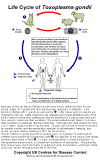|
|
| |
| Causative Agent |
-
Toxoplasmosis is a disease caused by the
protozoan parasite, Toxoplasma
gondii.
|
| Images |
|
Click on
image to
enlarge. |
 |
|
Life cycle of
Toxoplasma gondii. |
|
| Distribution |
|
Geographic: |
-
Common throughout the world.
|
|
Seasonality: |
|
|
|
| Hosts, Transmission and Life
Cycle |
| Hosts: |
-
Domestic or wild cats are the
definitive host, with feral cats being the main
reservoir for this parasite. Cougars
(Felis concolor)
in British Columbia have been reported to harbor this
parasite.
-
Other wildlife in BC and
North America known to act as
intermediate hosts and to have suffered
clinical effects of toxoplasmosis include:
-
moose (Alces alces), pronghorn antelope (Antilocapra americana), mule deer (Odocoileus hemionus), and white-tailed deer (O. virginianus);
-
black bear (Ursus
americanus), red fox (Vulpes
vulpes), skunk (Mephitidae),
opossum (Didelphis
virginiana), mink (Mustela
vison), and other small mammals.
-
Toxoplasmosis is also a
potentially serious
zoonotic disease. A waterborne
epidemic occurred in 1995 in
Victoria, BC and affected a number of humans.
|
|
Transmission and Life Cycle: |
-
Refer to above life cycle
diagram
-
Cats
ingest
cysts of T. gondii that
are contained in the tissues of
intermediate hosts.
Cysts then disintegrate within
the stomach and small intestine.
-
After multiplication and
reproduction within the walls of the intestines, egg-like
oocysts are passed in the feces. Oocysts can survive in the
environment for several months and are extremely resistant
to disinfectants, freezing, and drying.
-
Within a few days in the
external environment oocysts become infective and are
ingested incidental to feeding or drinking in areas
contaminated with cat feces.
-
Cysts
form in the tissues of
intermediate hosts, primarily in muscle and nervous tissue and, to a lesser extent, in
lungs, liver and kidney.
Cysts may persist for years.
-
The cycle continues when a
cat consumes meat contaminated with
cysts.
-
Humans may enter this cycle
either by consuming meat contaminated with
cysts or through ingestion of
food or water contaminated by cat feces.
|
|
| Signs and Symptoms |
-
Outward signs are
rarely observed in cats or
intermediate hosts.
-
In humans symptoms may include:
-
fever;
-
fatigue;
-
muscle pains and sore throat;
-
in
more severe cases,
inflammation of the brain and eyes, birth defects and even death can
occur in patients with suppressed
immune
systems.
|
| Meat Edible? |
-
Meat is edible if
cooked thoroughly to at least 67ºC.
-
When skinning infected animals, care should be taken,
as viable parasites may be present even if the infected animals show
no outward signs of disease.
|
| Human Health Concerns and
Risk Reduction |
| Health Concerns: |
-
Toxoplasmosis is of considerable risk to pregnant women, as T. gondii
can be readily transmitted from the mother through the placenta
to the developing fetus.
-
Complications in the developing fetus may lead to diminished vision,
mental deficiencies, convulsions and hydrocephalus (enlargement of
the skull caused by fluid accumulation).
-
Some
of these complications may not appear until later in life.
|
| Risk Reduction: |
-
Hands, utensils and
cutting surfaces should be washed with soap and water after handling
meat.
-
Thoroughly cook meat
(see above).
-
Pregnant women should
avoid contact with cat litter boxes, soil, raw meat and aborted
animals.
-
Cats should be fed
dry, canned or cooked food, not allowed to hunt out of doors, and
not allowed to scavenge from household garbage.
-
When gardening, gloves
should be worn and vegetables thoroughly washed prior to
consumption.
|
| Samples for Diagnosis |
-
Microscopic and
immunologic examination of secretions, excretions, body fluids and
other tissues collected either at
necropsy or
through
biopsy of
live tissue will help to determine the presence of T. gondii.
-
Whole carcasses should be submitted for
necropsy.
|
| Further Reading |
|
|
|
|



